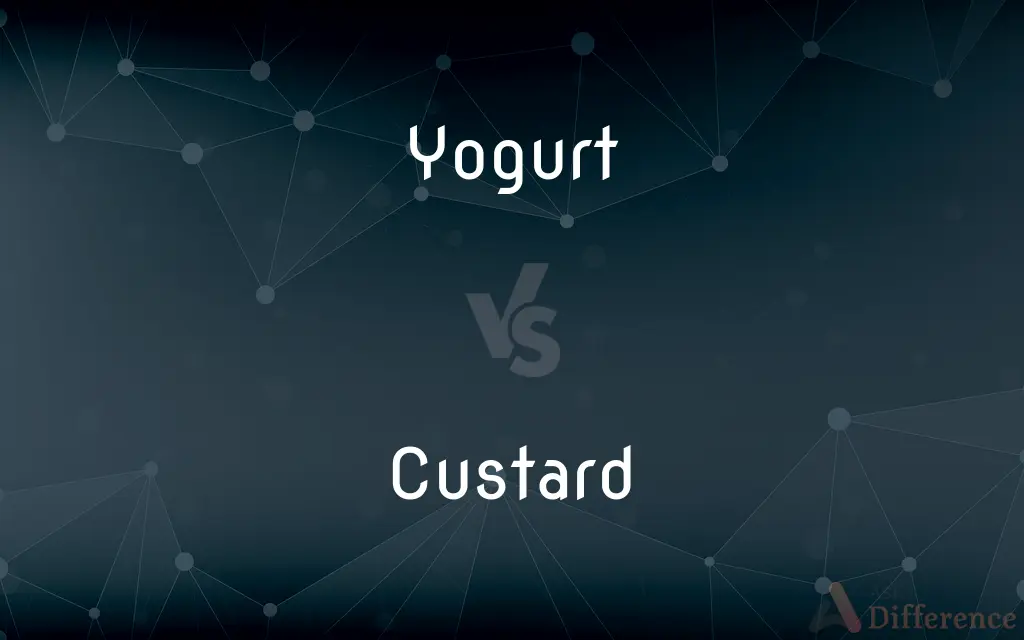Yogurt vs. Custard — What's the Difference?
By Tayyaba Rehman & Urooj Arif — Updated on February 26, 2024
Yogurt is a dairy product fermented from milk using specific bacteria, known for its tangy flavor and health benefits. Custard is a dessert or sauce made by thickening milk or cream with eggs, sugar, and characterized by its smooth texture.

Difference Between Yogurt and Custard
Table of Contents
ADVERTISEMENT
Key Differences
Yogurt and custard are both popular dairy-based foods, but they differ significantly in preparation, ingredients, and culinary uses. Yogurt is created through the fermentation of milk by bacteria, primarily Lactobacillus bulgaricus and Streptococcus thermophilus, which results in a tangy flavor and creamy texture. It is consumed for its probiotic benefits, aiding in digestion and gut health. Custard, on the other hand, is made by gently heating a mixture of milk or cream and egg yolks, sweetened with sugar. It can be flavored with vanilla, chocolate, or fruit. The presence of eggs in custard gives it a rich flavor and a smooth, thick consistency, making it a favored dessert or filling.
The nutritional profiles of yogurt and custard also differ. Yogurt is often praised for its high protein content, calcium, and probiotics, making it a healthy choice for breakfast or snacks. Custard, with its addition of eggs and sometimes sugar, tends to be higher in calories and fat, positioning it as more of an indulgent treat rather than a health food.
Yogurt is versatile, used in both sweet and savory dishes. It can be eaten alone, as part of breakfast bowls, smoothies, or as a base for sauces and marinades in various cuisines. Custard is primarily used in desserts, either as a base for pies and pastries, a filling for éclairs and doughnuts, or served as a sauce alongside cakes and puddings.
The choice between yogurt and custard depends on dietary preferences, nutritional goals, and the meal or dish being prepared. While yogurt offers health benefits and serves as a staple in daily diets, custard provides a rich, creamy texture and flavor suited for dessert occasions.
Comparison Chart
Base Ingredients
Milk, live bacterial cultures
Milk or cream, eggs, sugar
ADVERTISEMENT
Texture
Creamy, can be thick or runny
Smooth, thick
Flavor
Tangy
Sweet, can be flavored
Nutritional Value
High in protein, calcium, probiotics
Higher in calories, fat
Health Benefits
Aids digestion, supports gut health
Less emphasis on health, more indulgent
Culinary Uses
Breakfast, smoothies, sauces, marinades
Desserts, fillings, sauces
Preparation
Fermentation
Cooking with heat
Dietary Focus
Health-conscious consumers
Dessert and indulgence
Common Variants
Greek, Icelandic, flavored
Vanilla, chocolate, fruit-flavored
Serving Temperature
Cold
Can be served warm or cold
Compare with Definitions
Yogurt
Versatile in culinary uses.
Yogurt is used in marinades to tenderize meat.
Custard
Can be flavored in various ways.
Chocolate custard is a rich, decadent treat.
Yogurt
A fermented dairy product with a tangy taste.
Greek yogurt is thicker and higher in protein than regular yogurt.
Custard
Served as a sauce or dessert.
Fruit tarts are glazed with a thin layer of custard.
Yogurt
Consumed for probiotic benefits.
Yogurt is a staple in healthy breakfast bowls.
Custard
Richer and more indulgent.
Custard-based desserts are common in fine dining.
Yogurt
Can be eaten alone or mixed.
Flavored yogurts are popular as snacks.
Custard
A dessert made from milk, eggs, and sugar.
Vanilla custard is often used as pie filling.
Yogurt
Serves as a base for smoothies.
A yogurt-based smoothie is nutritious and filling.
Custard
Thickened by gentle cooking.
Custard for crème brûlée is baked in a water bath.
Yogurt
Yogurt (UK: ; US: , from Turkish: yoğurt) also spelled yoghurt, yogourt or yoghourt, is a food produced by bacterial fermentation of milk. The bacteria used to make yogurt are known as yogurt cultures.
Custard
Custard is a variety of culinary preparations based on sweetened milk, cheese, or cream cooked with egg or egg yolk to thicken it, and sometimes also flour, corn starch, or gelatin. Depending on the recipe, custard may vary in consistency from a thin pouring sauce (crème anglaise) to the thick pastry cream (crème pâtissière) used to fill éclairs.
Yogurt
A milk-based product stiffened by a bacterium-aided curdling process, and sometimes mixed with fruit or other flavoring.
Custard
A dessert or sweet sauce made with milk and eggs, or milk and a proprietary powder.
Custard
A dish consisting of milk, eggs, flavoring, and sometimes sugar, boiled or baked until set.
Custard
A type of sauce made from milk and eggs (and usually sugar, and sometimes vanilla or other flavourings) and thickened by heat, served hot poured over desserts, as a filling for some pies and cakes, or cold and solidified; also used as a base for some savoury dishes, such as quiches, or eaten as a stand-alone dessert; egg custard.
Custard
A mixture of milk and eggs, sweetened, and baked or boiled.
Custard
Sweetened mixture of milk and eggs baked or boiled or frozen
Common Curiosities
Is yogurt considered a probiotic?
Yes, yogurt contains probiotics, beneficial bacteria that support gut health, assuming it contains live and active cultures.
Are all yogurts the same?
No, yogurts vary in texture, fat content, and added ingredients. Greek yogurt, for example, is strained to remove whey, resulting in a thicker texture and higher protein content.
Can custard be made without eggs?
Traditional custard requires eggs for thickening, but there are egg-free versions using cornstarch or similar thickeners for dietary restrictions.
How does the nutritional content of yogurt and custard compare?
Yogurt is generally lower in calories and fat but higher in protein and probiotics, making it more health-focused than custard, which is richer due to eggs and sugar.
How long does homemade yogurt last?
Homemade yogurt can last up to 2 weeks when stored properly in the refrigerator.
What makes yogurt tangy?
Yogurt's tanginess comes from the lactic acid produced during the fermentation process by live bacterial cultures.
Can custard be frozen?
Yes, custard can be frozen, and it is the base for many ice cream recipes. However, its texture may change upon thawing if not intended for freezing.
Is yogurt suitable for cooking?
Yogurt is highly versatile and can be used in cooking, both in hot dishes and cold, though it may curdle at high temperatures if not stabilized.
What distinguishes custard from pudding?
Custard is egg-based and cooked with gentle heat, while pudding typically uses cornstarch or flour as a thickener and lacks eggs.
Why is custard considered indulgent?
Custard is considered indulgent due to its rich texture and high fat and calorie content, often enhanced with sweeteners and flavors.
Share Your Discovery

Previous Comparison
Pelican vs. Flamingo
Next Comparison
Centering vs. CentringAuthor Spotlight
Written by
Tayyaba RehmanTayyaba Rehman is a distinguished writer, currently serving as a primary contributor to askdifference.com. As a researcher in semantics and etymology, Tayyaba's passion for the complexity of languages and their distinctions has found a perfect home on the platform. Tayyaba delves into the intricacies of language, distinguishing between commonly confused words and phrases, thereby providing clarity for readers worldwide.
Co-written by
Urooj ArifUrooj is a skilled content writer at Ask Difference, known for her exceptional ability to simplify complex topics into engaging and informative content. With a passion for research and a flair for clear, concise writing, she consistently delivers articles that resonate with our diverse audience.














































